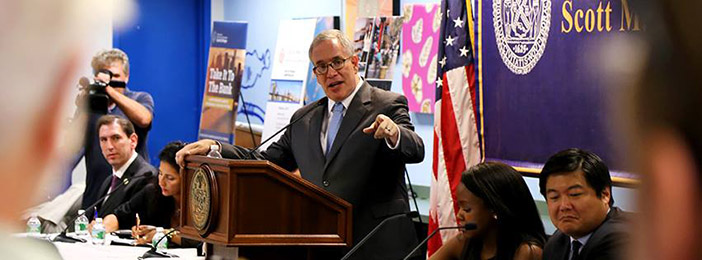Photo Courtesy of City Comptroller’s Office.
City Comptroller Scott Stringer indicated that he’s concerned about certain economic trends that have persisted in NYC since the beginning of the year.
By Forum Staff
Although the City’s economy expanded 2.6 percent during the late summer and early autumn of 2016, according to the latest Quarterly Economic Update released last Friday, concerning trends have persisted since the beginning of the year, said City Comptroller Scott Stringer.
In the third quarter, 26,800 private sector-jobs were created, the report indicated. However, Stringer noted, most new jobs – 14,300, or 53.4 percent of all growth – were in low-wage industries, which pay an average wage of about $42,000. Mid-wage jobs grew by 13,700, more than double the 6,900 of these jobs added in the second quarter. The City lost 1,100 high-wage jobs, the second consecutive quarterly drop – which has not happened since 2009, Stringer added.
Released every quarter, the comptroller’s Quarterly Economic Update examines a broad range of data that reflect current economic conditions in the five boroughs. The report also highlights relevant national indicators. Though numbers can change significantly from quarter to quarter, they can be used to inform what could be potential long-term trends.
“While New York City’s economy continues to expand, we’re seeing areas of concern emerge – areas for which we have to prepare and plan,” Stringer said. “Is this a reason for alarm now? No. But if some of these trends continue next quarter or farther down the road, should we be concerned? Probably. As I’ve said, when times are good, we have to make smart, strategic investments and properly save for when tougher times arrive. That’s something we must consider as we watch these numbers closely over the coming months.”
Commercial real estate improved during the third quarter. While the Manhattan office vacancy rate increased to 9.1 percent from 8.9 percent a year ago, new leasing totaled 6.9 million square-feet in late summer/early autumn, which is 5.8 percent higher than the third quarter of 2015. That increase follows four consecutive quarters of contraction, Stringer said. The residential housing market had more mixed results, as prices in Manhattan rose, he noted, but the number of home sales fell.
The third quarter Economic Update was prepared just prior to the presidential election. Other findings include:
Personal income tax collection growth remained weak
- Personal income tax revenues – an indicator that reflects both wages and non-wage income and serves as a proxy for total personal income – rose 0.6 percent year-over-year to $2.2 billion.
- Personal income taxes withheld from paychecks, which reflect trends in employment and wages, grew 2.2 percent to over $1.7 billion in the third quarter. Estimated tax payments – a reflection of non-wage income like capital gains and rental income – fell 9.6 percent compared to a year ago, hitting $460 million.
Residential real estate prices continued to increase
- The average home sale price in Manhattan rose 17 percent from a year ago to over $2 million, and the average price per square-foot rose 13 percent to $1,692.
- These Manhattan prices were skewed higher by new developments. The median sales price of a new development almost doubled to $4 million in the third quarter, while the median price of resold homes rose only 2.6 percent to $950,000.
- In Brooklyn and Queens, housing prices and sales both increased. In Brooklyn, the average sales price rose 14.8 percent to $983,511; while in Queens the average sales price rose 7.6 percent to $561,966.

